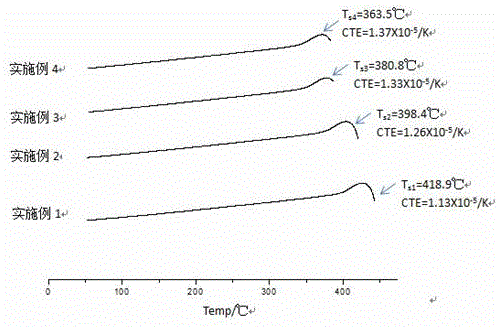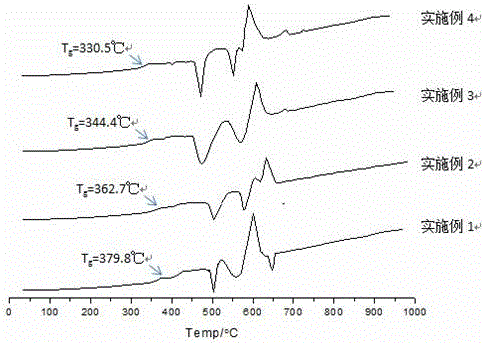Fe-containing low-temperature sealing glass as well as preparation and use methods thereof
A technology of sealing glass and low temperature, which is applied in the field of low-temperature precision packaging glass, can solve the problems of valence change, difficulty in ensuring the stability of sealing glass and refractive index stability, etc., and achieve improved sealing performance, low price and stable process Effect
- Summary
- Abstract
- Description
- Claims
- Application Information
AI Technical Summary
Problems solved by technology
Method used
Image
Examples
Embodiment 1
[0033] According to the proportioning of each component of the embodiment 1 of table 1, take respectively analytical pure raw material (B 2 o 3 、 Bi 2 o 3 , ZnO, Fe 2 o 3 ), use a planetary ball mill for 24 hours to mix evenly; then put the powder into a platinum crucible, place it in the air atmosphere of a box-type resistance furnace, heat it to 1000°C at 3°C / min, and keep it warm for 1 hour; then, take out the crucible, Pour the melt into deionized water for rapid cooling, and dry to obtain fragments of glass melt; grind and pass through a 100-mesh sieve to obtain glass powder. Mix glass powder with polyvinyl alcohol, fish oil, ethanol and toluene (80%, 2%, 1%, 10%, 7% by weight) to form a slurry, and disperse evenly in a ball mill; tape casting, natural Dry, then cut into the embryo body of the desired shape; place the embryo body on the part to be sealed, heat up in an electric furnace at a rate of 2°C / min, keep it at 400°C for 1 hour, and then heat up at a rate of 2...
Embodiment 2
[0035] According to the proportioning of each component of the embodiment 2 of table 1, take respectively analytical pure raw material (B 2 o 3 、 Bi 2 o 3 , ZnO, Fe 2 o 3), and mixed evenly with a planetary ball mill for 24 hours; then put the powder into a platinum crucible, place it in the air atmosphere of a box-type resistance furnace, heat it to 980°C at 3°C / min, and keep it warm for 1 hour; then, take out the crucible, Pour the melt into deionized water for rapid cooling, and dry to obtain fragments of glass melt; grind and pass through a 100-mesh sieve to obtain glass powder. Mix glass powder with methylcellulose, polyvinyl alcohol, n-butanol and acetone (82%, 2%, 2%, 8%, 6% by weight) to form a slurry, and disperse evenly in a ball mill; Stretching, drying naturally, and then cutting the embryo body into the desired shape; placing the embryo body on the part to be sealed, heating it in an electric furnace at a rate of 2°C / min, keeping it at 380°C for 1 hour, and t...
Embodiment 3
[0037] According to the proportioning ratio of each component in Table 1 Example 3, the analytically pure raw material (B 2 o 3 、 Bi 2 o 3 , ZnO, Fe 2 o 3 ), use a planetary ball mill for 24 hours to mix evenly; then put the powder into a platinum crucible, place it in the air atmosphere of a box-type resistance furnace, heat it to 950°C at 3°C / min, and keep it warm for 1 hour; then, take out the crucible, Pour the melt into deionized water for rapid cooling, and dry to obtain fragments of glass melt; grind and pass through a 100-mesh sieve to obtain glass powder. Mix glass powder with epoxy resin, polyacrylamide, isopropanol and toluene (84%, 1.5%, 0.5%, 9%, 5% by weight) to form a slurry, and disperse evenly in a ball mill; casting Shaping, drying naturally, and then cutting into the embryo body of the desired shape; place the embryo body on the part to be sealed, heat up at a rate of 2°C / min in an electric furnace, keep it at 360°C for 1 hour, and then heat it at 2°C / m...
PUM
| Property | Measurement | Unit |
|---|---|---|
| Softening point | aaaaa | aaaaa |
| Linear expansion coefficient | aaaaa | aaaaa |
| Softening point | aaaaa | aaaaa |
Abstract
Description
Claims
Application Information
 Login to View More
Login to View More - R&D
- Intellectual Property
- Life Sciences
- Materials
- Tech Scout
- Unparalleled Data Quality
- Higher Quality Content
- 60% Fewer Hallucinations
Browse by: Latest US Patents, China's latest patents, Technical Efficacy Thesaurus, Application Domain, Technology Topic, Popular Technical Reports.
© 2025 PatSnap. All rights reserved.Legal|Privacy policy|Modern Slavery Act Transparency Statement|Sitemap|About US| Contact US: help@patsnap.com



